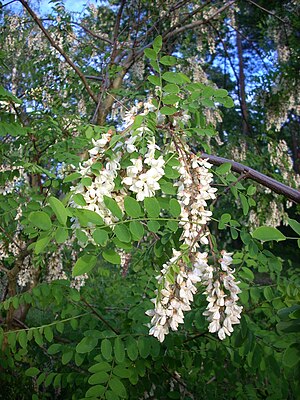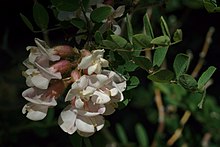Robinieae
| Robinieae | ||||||||||||
|---|---|---|---|---|---|---|---|---|---|---|---|---|

Common black locust ( Robinia pseudoacacia ) |
||||||||||||
| Systematics | ||||||||||||
|
||||||||||||
| Scientific name | ||||||||||||
| Robinieae | ||||||||||||
| Bercht. & J. Presl |
Robinieae is a tribe in the subfamily of the butterflies (Faboideae) within the legume family (Fabaceae). Their species are originally only native to the New World .
description

Appearance and leaves
They are perennial herbaceous plants , shrubs or trees . The parts of the plant are sometimes covered with glandular hairs ( trichomes ).
The alternate leaves consist of a petiole and a leaf blade. The petiole is padded. The leaf blade is pinnate in pairs or unpaired. The leaflets are more or less opposite to each other on the rachis. There may be narrow stipules , sometimes they are transformed into spines or they are missing. There are also often stipules of the leaflets present.
Inflorescences and flowers
Lateral, single or multiple, mostly hanging, racemose inflorescences are formed in the leaf axils . The membranous bracts fall out early.
The hermaphrodite flowers are zygomorph are fünfzählig double perianth (perianth). The five sepals are bell-shaped, sometimes fused with two lips; of the calyx teeth, two are more or less fused together. The corolla has the typical structure of the Pea family with five petals . The flag often has appendages at its base. The wings are not fused with the shuttle. Of the ten stamens , one is free or they are all fused together, but rarely form a closed tube. The anthers are all more or less the same. The only upper carpel usually contains a few to many, rarely only two to one ovules .
Fruits and seeds
The woody to thin-leathery, two-lobed legumes rarely contain only one, usually a few or many seeds and are rarely septate between them. The seeds are broadly ovate or oblong and flat.
distribution
The original range is in the New World. A particularly large number of species are native to Central and western South America.


Systematics
The tribe Robinieae was set up in 1820 by Friedrich von Berchtold and Jan Svatopluk Presl in O přirozenosti rostlin aneb rostlinář:… , p. 229.
The tribe Robinieae contains about eleven genera and about 70 species in the New World :
- Coursetia DC. (Syn .: Benthamantha Alef. , Callistylon Pittier , Chiovendaea Speg. , Cracca Benth. , Humboldtiella Harms , Neocracca Kuntze ): The almost 40 species are common in the New World.
-
Genistidium I.M.Johnst. : There is only one type:
- Genistidium dumosum I.M.Johnst. : It occurs in Mexico in the states of Coahuila and Nuevo León and in the USA only in Texas . This shrub is rare.
-
Gliricidia Kunth : The only two kinds are common in the Neotropic . Including:
- Gliricidia sepium (Jacq.) Walp. : It is grown in the tropical belt.
-
Lifting stigma Urb. : There is only one type:
- Hebestigma cubense (Kunth) Urb. : Itonlythrives in seasonal dry forests in Cuba .
- Lennea Klotzsch : The only three types are common in Central America.
-
Olneya A.Gray : There is only one type:
- Desert ironwood ( Olneya tesota A.Gray ): The distribution area ranges from Arizona and California to the Mexican states of Baja California , Baja California Sur and Sonora .
-
Petteria A.Gray : The four or so species are distributed from the USA to Mexico, including, for example:
- Petterie ( Petteria ramentacea ).
- Poissonia Baill. : The four or so species are distributed in Peru, Bolivia and Argentina.
- Poitea Vent. (Syn .: Bembicidium Rydb. , Corynella DC. , Notodon Urb. , Sabinea DC. , Sauvallella Rydb. , Vilmorinia DC. ): There are about 13 species.
- Robinia ( Robinia L. ): The four (to ten) species are distributed from North to Central America.
-
Sphinctospermum Rose : There is only one species:
- Sphinctospermum constrictum ( S. Watson) rose : It occurs in Arizona and Mexico.
swell
- Hang Sun, Bruce Bartholomew: Robinieae. , P. 320 - online with the same text as the printed work , In: Wu Zheng-yi, Peter H. Raven, Deyuan Hong (Ed.): Flora of China. Volume 10: Fabaceae , Science Press and Missouri Botanical Garden Press, Beijing and St. Louis 2010, ISBN 978-1-930723-91-7 . (Sections Description and Systematics)
- Robert Hegnauer: Chemotaxonomy of Plants , Volume XIB-2, Springer, 2001. ISBN 3-7643-5862-9 (Robinieae: Page 261-276)
- Matt Lavin, Martin F. Wojciechowski, Peter Gasson, Colin Hughes & Elisabeth Wheeler: Phylogeny of robinioid legumes (Fabaceae) revisited: Coursetia and Gliricidia recircumscribed, and a biogeographical appraisal of the caribbean endemics , In: Systematic Botany , Volume 28, No. 2, 2003, pp. 387-409.
Individual evidence
- ↑ Taxonomy of the Robinieae tribe in GRIN.
- ^ A b David John Mabberley: Mabberley's Plant-Book. A portable dictionary of plants, their classification and uses . 3rd edition, Cambridge University Press 2008. ISBN 978-0-521-82071-4 .
- ↑ Data sheet at International Legume Database Information Service = ILDIS - LegumeWeb - World Database of Legumes , Version 10.38 from July 20, 2010.
- ↑ Data sheet at International Legume Database Information Service = ILDIS - LegumeWeb - World Database of Legumes , Version 10.38 from July 20, 2010.
- ↑ Data sheet at International Legume Database Information Service = ILDIS - LegumeWeb - World Database of Legumes , Version 10.38 from July 20, 2010.
- ↑ Data sheet at International Legume Database Information Service = ILDIS - LegumeWeb - World Database of Legumes , Version 10.38 from July 20, 2010.


